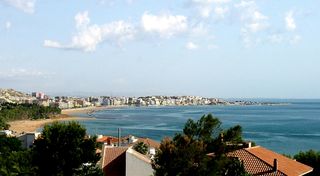
Pythagoras of Samos was an ancient Ionian Greek philosopher and the eponymous founder of Pythagoreanism. His political and religious teachings were well known in Magna Graecia and influenced the philosophies of Plato, Aristotle, and, through them, Western philosophy. Knowledge of his life is clouded by legend, but he appears to have been the son of Mnesarchus, a gem-engraver on the island of Samos. Modern scholars disagree regarding Pythagoras's education and influences, but they do agree that, around 530 BC, he travelled to Croton in southern Italy, where he founded a school in which initiates were sworn to secrecy and lived a communal, ascetic lifestyle. This lifestyle entailed a number of dietary prohibitions, traditionally said to have included vegetarianism, although modern scholars doubt that he ever advocated for complete vegetarianism.

Pre-Socratic philosophy is ancient Greek philosophy before Socrates and schools contemporary to Socrates that were not influenced by him. In Classical antiquity, these thinkers were sometimes called physiologoi or sophoi. Thales, one of the Seven Sages of Greece, is considered the first philosopher. The inquiries of these early philosophers spanned the workings of the natural world as well as human society, ethics, and religion, seeking explanations based on natural principles rather than the actions of gods. They introduced to the West the notion of the world as a kosmos, an ordered arrangement that could be understood via rational inquiry. The pre-Socratics were the forerunners of what became Western philosophy as well as natural philosophy, which later developed into the natural sciences. Significant figures include: the Milesians, Xenophanes, Heraclitus, Parmenides, Empedocles, Zeno of Elea, Anaxagoras, Democritus, and Pythagoras.

This is a timeline of ancient Greece from its emergence around 800 BC to its subjection to the Roman Empire in 146 BC.

Milo of Croton was a 6th-century BC wrestler from the Magna Graecian city of Croton, who enjoyed a brilliant wrestling career and won many victories in the most important athletic festivals of ancient Greece. His father was named Diotimus (Διοτίμος). In addition to his athletic victories, Milo is credited by the ancient commentator Diodorus Siculus with leading his fellow citizens to a military triumph over neighbouring Sybaris in 510 BC.

Miletus was an ancient Greek city on the western coast of Anatolia, near the mouth of the Maeander River in ancient Caria. Its ruins are located near the modern village of Balat in Aydın Province, Turkey. Before the Persian invasion in the middle of the 6th century BC, Miletus was considered among the greatest and wealthiest of Greek cities.

Crotone is a city and comune in Calabria. Founded c. 710 BC as the Achaean colony of Kroton, it was known as Cotrone from the Middle Ages until 1928, when its name was changed to the current one. In 1992, it became the capital of the newly established Province of Crotone. As of August 2018, its population was about 65,000.
The year 548 BC was a year of the pre-Julian Roman calendar. In the Roman Empire, it was known as year 206 Ab urbe condita. The denomination 548 BC for this year has been used since the early medieval period, when the Anno Domini calendar era became the prevalent method in Europe for naming years.

Croton-on-Hudson is a village in Westchester County, New York, United States. The population was 8,070 at the 2010 census. It is located in the town of Cortlandt as part of New York City's northern suburbs. The village was incorporated in 1898.

Croton–Harmon station is a train station in Croton-on-Hudson, New York. It serves the Metro-North Railroad's Hudson Line and all Amtrak lines running along the Empire Corridor. It is the main transfer point between the Hudson Line's local and express service and marks the northern endpoint of third-rail electrification on the route.

Croton is an extensive flowering plant genus in the spurge family, Euphorbiaceae. The plants of this genus were described and introduced to Europeans by Georg Eberhard Rumphius. The common names for this genus are rushfoil and croton, but the latter also refers to Codiaeum variegatum. The generic name comes from the Greek κρότος, which means "tick" and refers to the shape of the seeds of certain species.

The Croton Aqueduct or Old Croton Aqueduct was a large and complex water distribution system constructed for New York City between 1837 and 1842. The great aqueducts, which were among the first in the United States, carried water by gravity 41 miles (66 km) from the Croton River in Westchester County to reservoirs in Manhattan. It was built because local water resources had become polluted and inadequate for the growing population of the city. Although the aqueduct was largely superseded by the New Croton Aqueduct, which was built in 1890, the Old Croton Aqueduct remained in service until 1955.

The Bog Brook Reservoir is a 379-acre (153 ha) reservoir in the Croton Watershed in southern New York State, part of the New York City water supply system. It is located in the town of Southeast in Putnam County, approximately 38 miles (61 km) north of New York City. It was formed by the damming of Bog Brook, a small tributary of the East Branch of the Croton River. The reservoir was put into service in 1892, making it one of the older in the system.

The Croton Falls Reservoir is a reservoir in the New York City water supply system in the Putnam County, New York townships of Carmel, and Southeast, roughly 50 miles (80 km) north of New York City. Part of the system's Croton Watershed, it was formed by impounding the West Branch and Middle Branch of the Croton River, tributaries of the Croton River, which flows into the Hudson River.

The Muscoot Reservoir is a reservoir in the New York City water supply system in northern Westchester County, New York, located directly north of the village of Katonah. Part of the system's Croton Watershed, it is 25 miles north of the City. It was constructed at the beginning of the 19th century by impounding the Muscoot River, a tributary of the Croton River, in turn a tributary of the Hudson River.

The New Croton Reservoir is a reservoir in Westchester County, New York, part of the New York City water supply system lying approximately 22 miles (35 km) north of New York City. It is the collecting point for water from all reservoirs in the Croton Watershed.

The Croton River is a river in southern New York with three principal tributaries: the West Branch, Middle Branch, and East Branch. Their waters, all part of the New York City water supply system, join downstream from the Croton Falls Reservoir. Together, their waters and the reservoirs linked to them represent the northern half of the New York City water system's Croton Watershed.

Miletus is a genus of butterflies sometimes called brownies. Its species are found in the eastern Palearctic realm and the Indomalayan realm, and some stray east of the Wallace Line. The genus was erected by Jacob Hübner around 1819. Miletus is the type genus of the subfamily Miletinae.

The East Branch Croton River is a tributary of the Croton River in Dutchess, Putnam, and Westchester counties in the state of New York. It lies within the Croton River watershed and is part of the New York City water supply system's Croton Watershed.
















